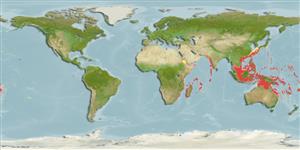Ophiarachnella infernalis (Müller & Troschel, 1842)
| Native range | All suitable habitat | Point map | Year 2050 |

|
| This map was computer-generated and has not yet been reviewed. |
| Ophiarachnella infernalis AquaMaps Data sources: GBIF OBIS |
Hochladen Photos
Google Bild |
No photo available for this species.No drawings available for Ophiodermatidae.
Google Bild |
No photo available for this species.
Classification / Names Common names | Synonyms | CoL | ITIS | WoRMS
Ophiuroidea | Ophiacanthida | Ophiodermatidae
Environment: milieu / climate zone / depth range / distribution range Ökologie
; tiefenbereich 0 - 233 m (Ref. 81020). Subtropical
Verbreitung Länder | FAO Gebiete | Ecosystems | Vorkommen | Einführungen
Indo-West Pacific.
Length at first maturity / Size / Gewicht / Alter
Maturity: Lm ? range ? - ? cm Max length : 0.9 cm WD Männchen/unbestimmt; (Ref. 87041)
Size refers to disc diameter (Ref. 87041).
Life cycle and mating behavior Geschlechtsreife | Fortpflanzung | Ablaichen | Eier | Fecundity | Larven
Members of the class Ophiuroidea are mostly gonochoric, others are protandric. Fertilization is external. Brooding is common, bursae is used as brood chambers where the embryos develop into juveniles and later crawl out from the bursal slits. Life cycle: Embryos hatch into free-swimming planktotrophic larvae and later metamorphose into tiny brittle stars which sink down the bottom where they grow into adult form.
Hauptreferenz
Referenzen | Koordinator | Partner
Mortensen, T. 1934. (Ref. 77931)
IUCN Rote Liste Status (Ref. 130435: Version 2024-1)
CITES Status (Ref. 108899)
Not Evaluated
CMS (Ref. 116361)
Not Evaluated
Bedrohung für Menschen
Harmless
Nutzung durch Menschen
| FishSource |
Tools
Mehr Information
Trophic Ecology
Nahrungsorganismen
Nahrung
Nahrungsaufnahme
Nahrungsmenge
Räuber
Nahrung
Nahrungsaufnahme
Nahrungsmenge
Räuber
Ecology
Population dynamics
Wachstum
Alter/Größe
Länge-Gewicht
Länge-Länge
Längenhäufigkeiten
Mass conversion
Rekrutierung
Dichte
Alter/Größe
Länge-Gewicht
Länge-Länge
Längenhäufigkeiten
Mass conversion
Rekrutierung
Dichte
Life cycle
Distribution
Human Related
Aquakultur Profil
Stamps, Coins Misc.
Stamps, Coins Misc.
Outreach
References
Internet Quellen
BHL | BOLD Systems | CISTI | DiscoverLife | FAO(Publication : search) | Fishipedia | GenBank (Genom, nucleotide) | GloBI | Gomexsi | Google Books | Google Scholar | Google | PubMed | Tree of Life | Wikipedia (Gehe zu, Suchen) | Zoological Record
Estimates based on models
Preferred temperature
(Ref. 115969): 21.4 - 28.4, mean 27 (based on 859 cells).


